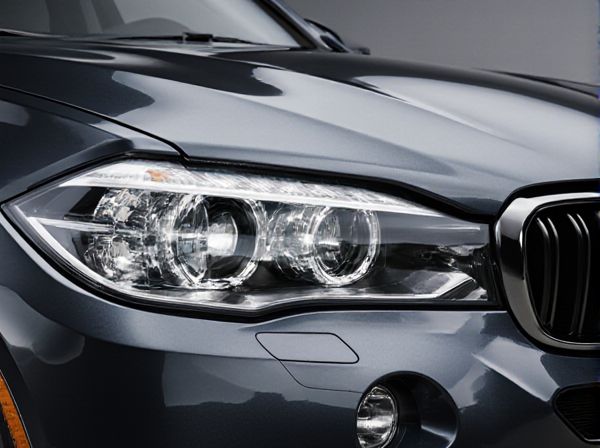
Photo illustration: Parabolic Reflector vs Free-Form Reflector
Parabolic reflectors focus light or signals into a single point, ensuring high gain and precise directionality for applications like satellite dishes and headlights. Free-form reflectors offer customizable shapes that optimize light distribution based on specific design requirements, improving efficiency in complex lighting environments. You can choose between these reflectors depending on whether precision focal convergence or tailored illumination patterns are the priority.
Table of Comparison
| Feature | Parabolic Reflector | Free-Form Reflector |
|---|---|---|
| Design | Traditional curved parabolic mirror | Complex, asymmetrical shape optimized for light distribution |
| Light Output | Focused beam, limited control | Enhanced beam pattern, precise light control |
| Efficiency | Moderate reflection efficiency | High reflection efficiency, reduced light loss |
| Visibility | Standard illumination range | Improved visibility with wider, uniform coverage |
| Manufacturing Cost | Lower cost, simpler production | Higher cost, complex fabrication |
| Application | Common in older or budget vehicles | Used in modern, high-performance headlights |
Introduction to Reflector Technologies
Parabolic reflectors use a precise curved surface to focus light or radio waves to a single focal point, enabling efficient signal concentration and minimal distortion. Free-form reflectors feature complex, non-symmetrical shapes tailored to optimize performance for specific applications, enhancing flexibility in directing energy or light patterns. Both reflector technologies play crucial roles in satellite communications, lighting, and radar systems by improving signal strength and coverage.
Overview of Parabolic Reflectors
Parabolic reflectors feature a precise parabolic shape that focuses incoming parallel rays to a single focal point, enhancing signal strength and accuracy in applications like satellite dishes and telescopes. Their design enables efficient light or radio wave collection by reflecting energy uniformly, resulting in high-gain performance essential for long-distance communication and energy concentration. Unlike free-form reflectors, parabolic reflectors maintain predictable optical properties due to their symmetrical geometry, making them ideal for systems requiring precise focal alignment.
Overview of Free-Form Reflectors
Free-form reflectors utilize complex, non-symmetrical shapes designed to optimize light distribution and improve illumination uniformity compared to traditional parabolic reflectors. These reflectors enhance energy efficiency by precisely controlling beam angles and minimizing light loss, making them ideal for applications requiring customized lighting patterns. Advanced manufacturing techniques enable the production of free-form reflectors with high precision, offering superior performance in automotive headlights, street lighting, and architectural illumination.
Design Principles and Geometry
Parabolic reflectors use a rotationally symmetric geometry defined by a paraboloid to focus parallel rays onto a single focal point, optimizing signal concentration with precise mathematical curvature. Free-form reflectors feature complex, non-symmetric surfaces designed through advanced computational algorithms to tailor the reflection pattern for specific applications, improving efficiency and coverage. Their design principles prioritize customized beam shaping and flexibility, contrasting with the standardized and predictable geometry of parabolic reflectors.
Light Distribution and Efficiency
Parabolic reflectors deliver uniform, focused light with minimal scattering, maximizing intensity and efficiency for targeted applications such as spotlights and telescopes. Free-form reflectors offer customized light distribution tailored to complex shapes and environments, enhancing efficiency by directing light precisely where needed and reducing wastage. While parabolic designs excel in maintaining beam coherence, free-form reflectors provide superior adaptability for diverse lighting scenarios and improved overall energy utilization.
Applications in Lighting Systems
Parabolic reflectors are widely used in lighting systems requiring focused, directional beams such as spotlights, searchlights, and automotive headlights due to their ability to direct light efficiently along a single axis. Free-form reflectors excel in architectural and stage lighting, where complex, customized light distributions enhance ambiance and visual effects by shaping light to fit irregular spaces and surfaces. These advanced reflector designs support energy-efficient illumination by optimizing light output and minimizing losses in specialized lighting applications.
Performance Comparison: Parabolic vs Free-Form
Parabolic reflectors provide highly efficient, focused beam patterns ideal for consistent signal strength and long-distance transmission, while free-form reflectors offer superior adaptability in shaping beams for complex coverage areas and minimizing interference. Performance comparison reveals that parabolic reflectors excel in applications demanding uniform gain and lower side lobes, whereas free-form reflectors optimize energy distribution in irregular environments with customized beamforms. Efficiency metrics highlight parabolic designs as optimal for narrow, high-gain applications, contrasted by free-form's advantage in tailored illumination and spatial freedom.
Manufacturing and Cost Considerations
Parabolic reflectors feature a symmetrical, curved surface that simplifies manufacturing using stamping or machining techniques, resulting in lower production costs compared to free-form reflectors. Free-form reflectors require complex, customized tooling and precision fabrication methods such as CNC machining or 3D printing, increasing both manufacturing complexity and expenses. Cost considerations favor parabolic reflectors for large-scale production due to standardized processes, while free-form reflectors justify higher costs with improved optical performance in specialized applications.
Advantages and Limitations
Parabolic reflectors provide precise, focused reflection ideal for applications requiring high directional accuracy, such as satellite dishes and telescopes, but their fixed shape limits versatility in complex lighting or signal patterns. Free-form reflectors offer adaptable geometries that optimize light or signal distribution for irregular or customized coverage areas, enhancing efficiency in advanced lighting systems and communications. However, free-form designs often require sophisticated manufacturing techniques and complex modeling, leading to higher costs and potential alignment challenges.
Future Trends in Reflector Design
Future trends in reflector design emphasize enhancing efficiency and adaptability, with parabolic reflectors maintaining their precision in focused light or signal projection due to their geometric simplicity and high gain. Free-form reflectors gain momentum by enabling customized light distribution patterns tailored for advanced applications like automotive lighting and solar concentrators, leveraging computational optimization and additive manufacturing. Integration of smart materials and adaptive surfaces in both reflector types points toward dynamic, real-time adjustment capabilities for improved performance in evolving environmental conditions.
 caratoz.com
caratoz.com